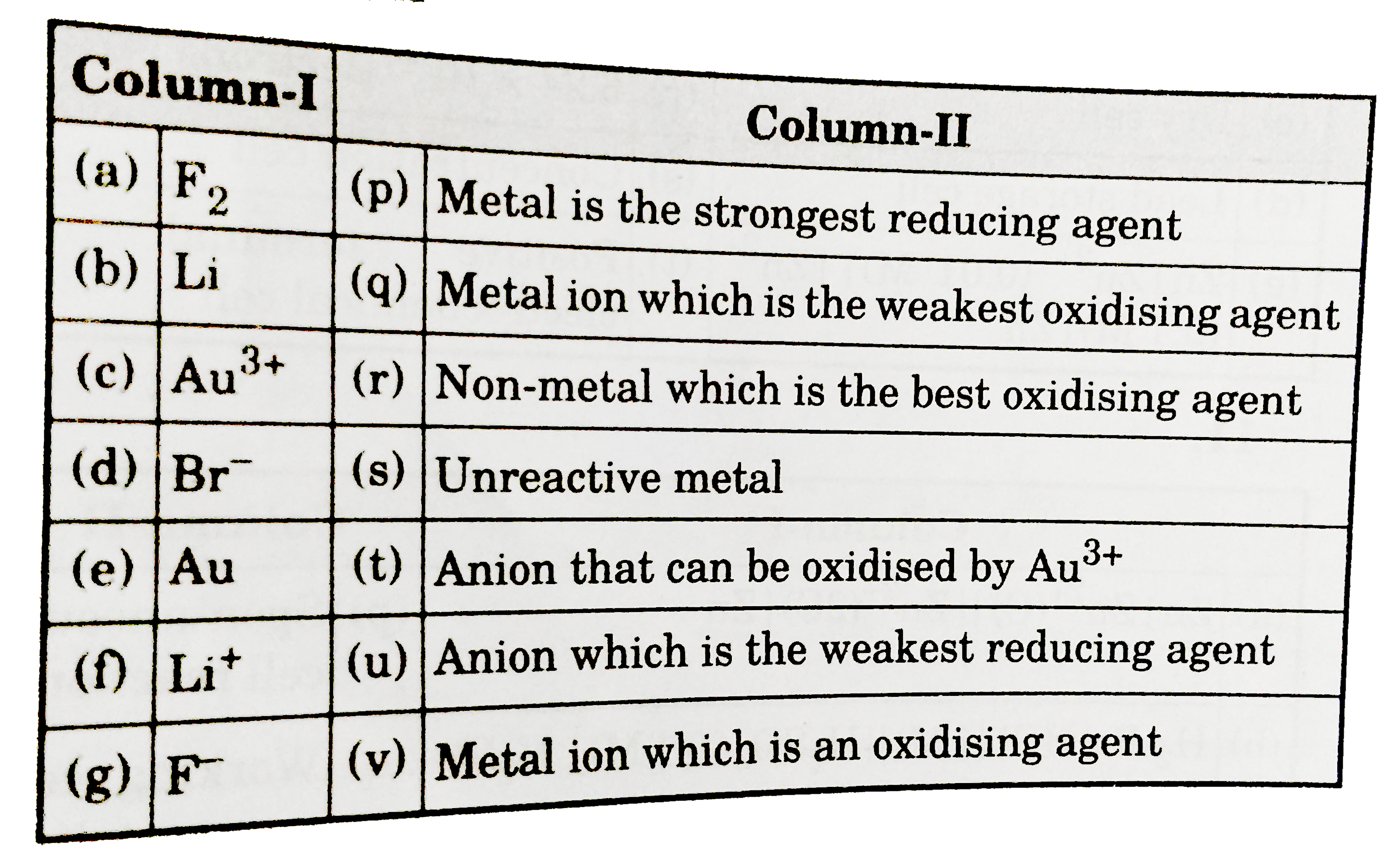Match the terms given in column I with the units given in column II

The correct Answer is:A, B, C, D
(i) has highest reduction potential. Hence, it is best oxidizing agent. Further, it is a non-metal, i.e., .
(ii) Li has lowest reduction potential or highest oxidation potential. Hence, it is strongest reducing agent. It is a metal , i.e., .
(iii) is +ve. hence, ions can undergo reduction and, therefore, act as an oxidizing agent, i.e., .
(iv) . hence ions can be oxidized by , i.e., .
(v) Au is unreactive metal. hence, .
(vi). has lowest reduction potential.hence, will be weakest oxidizing agent, i.e., .
(vii) has low oxidation potential . hence, is weakest reducing agent, i.e., .
Topper's Solved these Questions
- ELECTROCHEMISTRYBOOK - PRADEEPCHAPTER - ELECTROCHEMISTRYEXERCISE - NCERT EXEMPLAR PROBLEMS WITH ANSWERS, HINTS AND SOLUTIONS (ASSERTION AND REASON TYPE QUESTIONS)
10 Videos
- ELECTROCHEMISTRYBOOK - PRADEEPCHAPTER - ELECTROCHEMISTRYEXERCISE - NCERT EXEMPLAR PROBLEMS WITH ANSWERS, HINTS AND SOLUTIONS (LONG ANSWER QUESTIONS)
3 Videos
- ELECTROCHEMISTRYBOOK - PRADEEPCHAPTER - ELECTROCHEMISTRYEXERCISE - NCERT EXEMPLAR PROBLEMS WITH ANSWERS, HINTS AND SOLUTIONS (MULTIPLE QUESTIONS-II)
10 Videos
- D- AND F-BLOCK ELEMENTSBOOK - PRADEEPCHAPTER - D- AND F-BLOCK ELEMENTSEXERCISE - IMPORTANT QUESTIONS
30 Videos
- GENERAL PRINCIPLES AND PROCESSES OF ISOLATION OF ELEMENTS BOOK - PRADEEPCHAPTER - GENERAL PRINCIPLES AND PROCESSES OF ISOLATION OF ELEMENTS EXERCISE - Curiosity Questions
2 Videos
Similar Questions
Match the items of Column I and Column II on the basis of data given below :
E_(F_(2)//F^(-))^(Ï´)=2.87" V ",E_(Li^(+)//Li)^(Ï´)=3.5" V ",E_(Au^(3+)//Au)^(Ï´)=1.4" V ",E_(Br_(2)//Br^(-))^(Ï´)=1.09" V "

View SolutionMatch the items of Column I and Column II on the basis of data given below:
(One to one match only)
E∘F2∣F− = 2.87 V, ELi+∣(Li) = -3.5 V,
E∘Au3+∣Au = 1.4 V, E∘Br2∣Br− = 1.09V

View Solution
Knowledge Check
Arrange the following metals in increasing order of their reducing power.
[ Given : E∘K+/K=−2.93V,E∘Ag+/Ag=+0.80V,E∘Al3/Al=−1.66V,E∘Au3+/Au=+1.40V,E∘Li+/Li=−3.05V]ALi<K<Al<Ag<AuBAu<Ag<Al<K<LiCK<Al<Au<Ag<LiDAl<Ag<Au<Li<KArrange the following metals in increasing order of their reducing power.
E∘K+/K=−2.93V,E∘Ag+/Ag=+0.80V,E∘Al3/Al=−1.66VE∘Au3+/Au=+1.40V,<br>E∘Li+/Li=−3.05VALi<K<Al<Ag<AuBAu<Ag<Al<K<LiCK<Al<Au<Ag<LiDAl<Ag<Au<Li<KIf E∘Au+/Au is 1.69 V and E∘Au3+/Au is 1.40 V, then E∘Au+/Au3+ will be :
A0.9 vB0.945 VC1.255 VDNone of these
Match the items of Column I and Column II on the basis of data given below:
(One to one match only)
E∘F2∣F− = 2.87 V, ELi+∣(Li) = -3.5 V,
E∘Au3+∣Au = 1.4 V, E∘Br2∣Br− = 1.09V

View SolutionIf E∘Au+/Au is 1.69 V and E∘Au3+/Au is 1.40 V, then E∘Au+/Au3+ will be :
View SolutionAn aqueous solution containing 1M each of Au3+,Cu2+,Ag+,Li+ is being electrolysed by using inert electrodes. The value of standard potentials are :
E∘Ag+/Ag=0.80V,E∘Cu+/Cu=0.34V and E∘Au+3/Au=1.50,E∘Li+/Li=−3.03V
will increasing voltage, the sequence of deposition of metals on the cathode will be :
View SolutionAn aqueous solution containing 1M each of Au3+,Cu2+,Ag+,Li+ is being electrolysed by using inert electrodes. The value of standard potentials are :
E∘Ag+/Ag=0.80V,E∘Cu+/Cu=0.34V and E∘Au+3/Au=1.50,E∘Li+/Li=−3.03V
will increasing voltage, the sequence of deposition of metals on the cathode will be :
View SolutionAn aqueous solution containing 1M each of Au3+,Cu2+,Ag+,Li+ is being electrolysed by using inert electrodes. The value of standard potentials are :
E∘Ag+/Ag=0.80V,E∘Cu+/Cu=0.34V and E∘Ag+3/Au=1.50,E∘Li+/Li=−3.03V
will increasing voltage, the sequence of deposition of metals on the cathode will be :
View Solution
